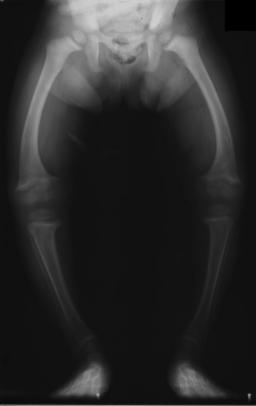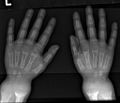Rickets facts for kids
Quick facts for kids Rickets |
|
|---|---|
 |
|
| X-ray of a two-year-old with rickets, showing bowed legs and weaker bones. | |
| Symptoms | Bowed legs, stunted growth, bone pain, large forehead, trouble sleeping |
| Complications | Bone fractures, muscle spasms, abnormally curved spine, intellectual disability |
| Usual onset | Childhood |
| Causes | Diet without enough vitamin D or calcium, dark skin, too little sun exposure, exclusive breastfeeding without supplementation, celiac disease, certain genetic conditions |
| Diagnostic method | Blood tests, X-rays |
| Similar conditions | Fanconi syndrome, scurvy, Lowe syndrome, osteomalacia |
| Prevention | Vitamin D supplements for exclusively-breastfed babies |
| Treatment | Vitamin D and calcium |
| Frequency | Relatively common (Middle East, Africa, Asia) |
Rickets is a health problem that mostly affects young children. It happens when children don't get enough vitamin D and calcium, which are super important for strong bones. This can make their bones soft and weak, almost like a sponge instead of being hard and strong. Sometimes, it can even cause legs to bend inwards (like knock-knees) or outwards (like bow-legs).
When adults have a similar problem, it's called osteomalacia.
The word 'rickets' comes from an old Greek word, rhakhis, which means 'spine'.
Contents
Why Do Kids Get Rickets?
To have strong, healthy bones, your body needs two main things: vitamin D and calcium.
Vitamin D helps your bones absorb, or 'take in,' calcium from the food you eat. If you don't have enough vitamin D, your body struggles to get the calcium it needs for your bones.
How Your Body Makes Vitamin D
Your human body can actually make its own vitamin D! It starts in your skin when ultraviolet light from the sun shines on it. This light helps your skin create vitamin D3 from something called cholesterol.
After that, your liver changes vitamin D3 into another form called calcitriol. This calcitriol is like a messenger that tells your body to send calcium from your blood into your bones. Your bones really need this calcium to grow strong and stay healthy.
Why Calcium is Important
Calcium is key for a process called calcification. This is when calcium helps make your bones bigger and stronger. If your body doesn't get enough calcium, your bones can become delicate and much easier to break.
How Can We Prevent Rickets?
Rickets can usually be prevented if a person gets enough calcium and vitamin D.
The best ways to do this are to spend time in the sun and eat foods that are rich in vitamin D and calcium. If someone can't get enough this way, they can take supplements. These are like vitamin pills that contain calcium and vitamin D.
Foods with Calcium
Many foods have a lot of calcium. Some good examples include:
- Milk and other dairy products, like cheeses.
- Some green vegetables, such as broccoli, spinach, and kale.
- Today, many foods are "fortified" with calcium and vitamin D. This means the vitamins were added when the food was made. These foods can include some kinds of orange juice, breakfast cereals, breads, and even bottled water. You can check the food's label to see how much calcium it has.
Your bones absorb calcium best when you take it in smaller amounts, around 500 to 600 grams or less at a time. Because of this, doctors often suggest eating smaller portions of calcium-rich foods throughout the day, instead of a lot all at once.
Getting Enough Vitamin D
There are three main ways to get vitamin D: sunlight, certain foods, or vitamin D supplements. However, many people find it hard to get enough vitamin D just from their diet.
Only a few foods naturally have a lot of vitamin D. These include:
- "Fatty fish" caught in the wild, like mackerel, salmon, and tuna.
- Cooked egg yolk.
- Vitamin D is also added to some foods, such as certain dairy products, cereals, and orange juices.
Breast milk might not have enough vitamin D to prevent rickets on its own. Babies who are only breastfed may be given vitamin D drops to make sure they don't get rickets. However, this risk is lower if both the mother and child get some sunlight. Children with darker skin may need extra vitamin D more often.
Who is at Risk for Rickets?
Some things can make a person more likely to get rickets:
- Age: Children between three and 36 months old are at the highest risk. This is because their bones are growing very quickly during this time.
- Early Birth: Babies born prematurely (earlier than normal) can be at higher risk.
- Location: Living in northern parts of the world, where there is less sunshine, increases the risk.
- Time Outdoors: Spending too little time outside can reduce vitamin D production.
- Sunscreen Use: Always wearing sunscreen when going out can decrease the amount of vitamin D your body makes by a lot (up to 95%). However, it's still important to wear sunscreen to prevent sunburn!
- Dietary Choices: Not eating enough foods with calcium or vitamin D, perhaps due to lactose intolerance or a strict vegetarian diet.
- Medical Conditions: Having a medical disorder like coeliac disease or taking certain anti-seizure medications can make it harder for the body to make or use vitamin D.
What Are the Symptoms of Rickets?
Signs and symptoms of rickets can include:
- Brittle (easily broken) bones or teeth.
- Bleeding more than normal.
- Stunted growth (not growing as much as a healthy child should).
- Sweating more than usual.
- Weakness (feeling tired all the time).
- Body pain.
Related pages
Images for kids
See also
 In Spanish: Raquitismo para niños
In Spanish: Raquitismo para niños





